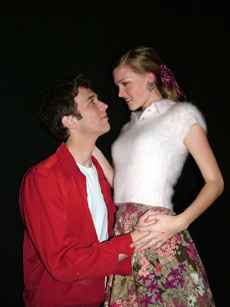
For the NKU Department of Theatre’s rendition of “Romeo and Juliet,” director Mike King chose to set the play in the 1950s to help the audience connect with the action happening on stage.
The actors not only had to play characters from 1595, but also take into consideration the customs of the 1950s. John West played the lead role of Romeo. In the past, West has landed supporting roles in NKU productions. He really proved himself as an actor in this role. Although he portrayed Romeo as a sappy love-struck young man, rather than a leading lover, it was a decision that he made as an actor and it was successful with the aid of the other characters surrounding him.
Juliet, played by senior Tracy Weiler, is the epitome of glamorous innocence. Weiler successfully possessed the look and attitude of a 16-year-old girl falling in love for the first time.
The stage chemistry between Juliet and the Nurse, played by Liz Goins, was unbeatable. The duo complimented each other with their opposite characters. Juliet was dependent on her parents, Nurse and Romeo throughout the entire play, whereas Nurse was a caregiver and independent.
Nurse’s boisterous personality and her odd sense of humor helped her become the comic relief of the Capulet family, whereas Mercutio, played by Timothy Rhoades, was the comical character of the Montague family. The choices he made as an actor were very contrasting to those of the other characters in the play. The vulgar actions and bold gestures won him the role of comical bad boy.
“Romeo and Juliet” was the starting point for a few freshmen this year. Vanessa Barlett used the character of Benvolio to break into the NKU play scene. The great emotion in her voice along with her mannerisms helped her shine among the number of supporting characters. Either first time jitters or getting lost in the emotions of her character caused her rate to be a little fast at times, but “Romeo and Juliet” was a great start to a theatre career at NKU.
The most impressive character in the play was Capulet, played by Josh Beshears. He outshined the lead actors with the believability of his character and his stage presence. From the moment he entered, the audience’s attention focused on the authoritative, charismatic father and businessman. His projection was perfect and the emotion he put into his character immaculate.
The costume design played a large part in the appearance of the play. The contrasting costumes helped the audience identify which family the different characters sided with. Not only were the different families dressed in different colors, but the colors also symbolized the characteristics of the families.
Blue hues were the dominant colors of the Montague family. The cool colors showed passive characters, as seen in the opening scene of the play. When Monatgue, played by Aaron LaVigne, and Lady Montague, Denise Devlin, made their first appearances, they were collected and passive.
On the other side of the color wheel, the Capulet family was dressed in red hues. The warm colors showed the hot temper of Capulet that was displayed throughout the entire play. Like her husband, Lady Capulet, played by Christine Krumme, was also a short-tempered character.
The set consisted of two wooden levels. The lower level was used mostly for outdoor scenes and for the Capulet house in certain scenes. The upper level was reserved for a bedroom and the infamous balcony scene.
Supporting the levels were metal beams that gave the Frank Sinatra inspired set a more sturdy and industrial appeal.
Although the play has been performed countless times during the past four centuries, this 1950s rendition is worth the admission.

